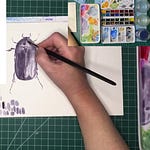Hi, friends!
Field sketching is hard, even for someone like me who draws and paints birds for a living. In the wild, your subjects are unpredictable — still one moment, moving or flying off the next. The key to sketching them is to let go of any notion that this is art. It isn’t. It’s visual note taking, and you have more than adequate skills to do this (the art, if you like, comes later based on your field sketches — and you have the skills to do this, too, even if you don’t realize it yet. But I digress).
Your only job in the moment is to jot down enough visual information to use later on, and to realize you have more than one opportunity to do this. The key is to have a strategy and stay flexible.
For example, I like to sketch groups of Canadian Geese on a flight break at the creek near my house. They are moving around, and it’s easy to lose track of my subject. My strategy is to get the overall shape and the relationship between head and body more or less correct. I sketch feather texture from another goose, and beak detail from yet another. I may lay this out in my journal as vignettes or I may graft the detail onto the first bird’s shape.
With a subject like Big Red from the live cam, I may rely on feather groupings to serve as my shorthand. Using the knowledge I gained by studying feather area charts, like the one you can find here from the Avian Report, I can search for feather groupings on my subject and then sketch my observations, fitting it together like a puzzle. (See this recent Note for more information on drawing using this method.)
Livestream Notes
Intro (Time Stamp 00:00)
Head Feather Map (Time Stamp 03:36)
Body Feather Map (Time Stamp 11:52)
Sketching Big Red (Time Stamp 23:53)
When sketching wildlife in general, it’s still helpful to learn general markings and shapes. One of my favorite books is J.C. Amberlyn’s Drawing Wildlife. It’s widely available, very easy to use, and gives you the “shorthand” to live sketch in the wild. Hope this helps!
xoSusannah
P.S. Keep scrolling for this week’s prompt.
P.P.S. What’s on my easel this week? Keep scrolling to find out!
P.P.P.S. Join this episode’s chat to share your journal pages, your thoughts, and cheer on others!
Wonder-Filled Wednesday
Every Wednesday at 1:30pm Eastern US time (Time Converter), we marvel in our nature journals together — draw along with me or just watch, ask questions, etc. Livestreams are hosted on Notes for everyone, and recorded/archived for paid subscribers.
Download the app to join me live:
Prompt And Resources For Practice
Listen to this episode with a 7-day free trial
Subscribe to Cricklewood Nature Journal to listen to this post and get 7 days of free access to the full post archives.














